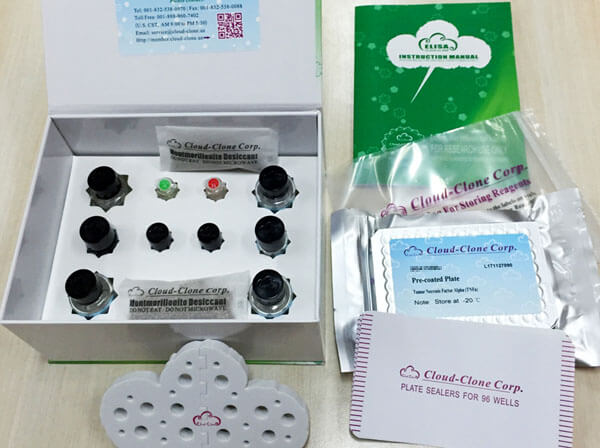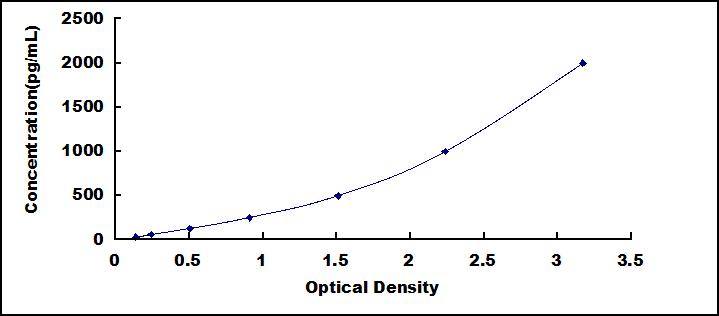ELISA Kit for Cardiac Troponin I (cTnI) 

TNNI3; TNNC1; CMH7; C-TnI; Troponin I Type 3; Troponin I Type 3, Cardiac
- UOM
- FOB US$ 454.00 US$ 648.00 US$ 2,916.00 US$ 5,508.00 US$ 45,360.00
- Quantity
Overview
Properties
- Product No.SEA478Mu
- Organism SpeciesMus musculus (Mouse) Same name, Different species.
- ApplicationsEnzyme-linked immunosorbent assay for Antigen Detection.
Research use only - DownloadInstruction Manual
- CategoryCardiovascular biology
Sign into your account
Share a new citation as an author
Upload your experimental result
Review

Contact us
Please fill in the blank.
Recovery
Matrices listed below were spiked with certain level of recombinant Cardiac Troponin I (cTnI) and the recovery rates were calculated by comparing the measured value to the expected amount of Cardiac Troponin I (cTnI) in samples.
| Matrix | Recovery range (%) | Average(%) |
| serum(n=5) | 92-105 | 101 |
| EDTA plasma(n=5) | 81-103 | 85 |
| heparin plasma(n=5) | 83-96 | 93 |
Precision
Intra-assay Precision (Precision within an assay): 3 samples with low, middle and high level Cardiac Troponin I (cTnI) were tested 20 times on one plate, respectively.
Inter-assay Precision (Precision between assays): 3 samples with low, middle and high level Cardiac Troponin I (cTnI) were tested on 3 different plates, 8 replicates in each plate.
CV(%) = SD/meanX100
Intra-Assay: CV<10%
Inter-Assay: CV<12%
Linearity
The linearity of the kit was assayed by testing samples spiked with appropriate concentration of Cardiac Troponin I (cTnI) and their serial dilutions. The results were demonstrated by the percentage of calculated concentration to the expected.
| Sample | 1:2 | 1:4 | 1:8 | 1:16 |
| serum(n=5) | 85-101% | 81-89% | 82-101% | 78-96% |
| EDTA plasma(n=5) | 95-103% | 94-104% | 79-95% | 80-97% |
| heparin plasma(n=5) | 91-103% | 78-91% | 89-96% | 79-101% |
Stability
The stability of kit is determined by the loss rate of activity. The loss rate of this kit is less than 5% within the expiration date under appropriate storage condition.
To minimize extra influence on the performance, operation procedures and lab conditions, especially room temperature, air humidity, incubator temperature should be strictly controlled. It is also strongly suggested that the whole assay is performed by the same operator from the beginning to the end.
Reagents and materials provided
| Reagents | Quantity | Reagents | Quantity |
| Pre-coated, ready to use 96-well strip plate | 1 | Plate sealer for 96 wells | 4 |
| Standard | 2 | Standard Diluent | 1×20mL |
| Detection Reagent A | 1×120µL | Assay Diluent A | 1×12mL |
| Detection Reagent B | 1×120µL | Assay Diluent B | 1×12mL |
| TMB Substrate | 1×9mL | Stop Solution | 1×6mL |
| Wash Buffer (30 × concentrate) | 1×20mL | Instruction manual | 1 |
Assay procedure summary
1. Prepare all reagents, samples and standards;
2. Add 100µL standard or sample to each well. Incubate 1 hours at 37°C;
3. Aspirate and add 100µL prepared Detection Reagent A. Incubate 1 hour at 37°C;
4. Aspirate and wash 3 times;
5. Add 100µL prepared Detection Reagent B. Incubate 30 minutes at 37°C;
6. Aspirate and wash 5 times;
7. Add 90µL Substrate Solution. Incubate 10-20 minutes at 37°C;
8. Add 50µL Stop Solution. Read at 450nm immediately.

Test principle
The test principle applied in this kit is Sandwich enzyme immunoassay. The microtiter plate provided in this kit has been pre-coated with an antibody specific to Cardiac Troponin I (cTnI). Standards or samples are then added to the appropriate microtiter plate wells with a biotin-conjugated antibody specific to Cardiac Troponin I (cTnI). Next, Avidin conjugated to Horseradish Peroxidase (HRP) is added to each microplate well and incubated. After TMB substrate solution is added, only those wells that contain Cardiac Troponin I (cTnI), biotin-conjugated antibody and enzyme-conjugated Avidin will exhibit a change in color. The enzyme-substrate reaction is terminated by the addition of sulphuric acid solution and the color change is measured spectrophotometrically at a wavelength of 450nm ± 10nm. The concentration of Cardiac Troponin I (cTnI) in the samples is then determined by comparing the O.D. of the samples to the standard curve.
Giveaways
Increment services
-
 Single-component Reagents of Assay Kit
Single-component Reagents of Assay Kit
-
 Lysis Buffer Specific for ELISA / CLIA
Lysis Buffer Specific for ELISA / CLIA
-
 Quality Control of Kit
Quality Control of Kit
-
 ELISA Kit Customized Service
ELISA Kit Customized Service
-
 Disease Model Customized Service
Disease Model Customized Service
-
 Serums Customized Service
Serums Customized Service
-
 TGFB1 Activation Reagent
TGFB1 Activation Reagent
-
 Real Time PCR Experimental Service
Real Time PCR Experimental Service
-
 Streptavidin
Streptavidin
-
 Fast blue Protein Stain solution
Fast blue Protein Stain solution
-
 Single-component Reagents of FLIA Kit
Single-component Reagents of FLIA Kit
-
 Streptavidin-Agarose Beads
Streptavidin-Agarose Beads
Citations
- The effects of caloric restriction and age on thyroid hormone signalling in the heart of ratsPl:Source
- Comparison of femoral and aortic remote ischaemia preconditioning for cardioprotection against myocardial ischaemia/reperfusion injury in a rat modelPubmed:25205781
- Cardioprotective effect of remote preconditioning of trauma and remote ischemia preconditioning in a rat model of myocardial ischemia/reperfusion injuryPubMed: 26136887
- Circulating miR-126 and miR-499 reflect progression of cardiovascular disease; correlations with uric acid and ejection fractionpubmed:27924211
- Cardiac biomarkers in dogs with visceral leishmaniasisS0301-732X2016000300004
- Cathepsin B aggravates coxsackievirus B3-induced myocarditis through activating the inflammasome and promoting pyroptosisPubmed:29360865
- Co-exposure of silica nanoparticles and methylmercury induced cardiac toxicity andPubmed:29727991
- Melatonin balance the autophagy and apoptosis by regulating UCP2 in the LPS-induced cardiomyopathyPubmed:29547569
- The Multivariate Regression Statistics Strategy to Investigate Content-Effect Correlation of Multiple Components in Traditional Chinese Medicine Based on a …Pubmed:29494523
- Protective effects of N (2)‑L‑alanyl‑L‑glutamine mediated by the JAK2/STAT3 signaling pathway on myocardial ischemia reperfusionPubmed:29393473
- Hydrogen‑rich solution against myocardial injury and aquaporin expression via the PI3K/Akt signaling pathway during cardiopulmonary bypass in ratsPubmed:29956781
- Protective Effects of Shenfu Injection against Myocardial Ischemia-Reperfusion Injury via Activation of eNOS in RatsPubmed:29910216
- Hydrogen‑rich solution attenuates myocardial injury caused by cardiopulmonary bypass in rats via the Janus‑activated kinase 2/signal transducer and activator of …Pubmed:29928398
- Enoxaparin attenuates doxorubicin induced cardiotoxicity in rats via interfering with oxidative stress, inflammation and apoptosisPubmed:29321061
- Signature-oriented investigation of the efficacy of multicomponent drugs against heart failurePubmed: 30230922
- Trimetazidine Attenuates Exhaustive Exercise-Induced Myocardial Injury in Rats via Regulation of the Nrf2/NF-κB Signaling PathwayPubmed: 30890937
- Could cardioprotective effect of ACE2 activator “diminazene aceturate” is more potent than ACE inhibitor “Enalapril” on acute myocardial infarction in rats?Pubmed: 30840489
- Inflammatory cytokines associated with cancer growth induce mitochondria and cytoskeleton alterations in cardiomyocytesPubmed: 30982981
- Electrochemical dual-aptamer-based biosensor for nonenzymatic detection of cardiac troponin I by nanohybrid electrocatalysts labeling combined with DNA …Pubmed: 30954926
- Protective effects of two novel nitronyl nitroxide radicals on heart failure induced by hypobaric hypoxiaPubmed: 31102744
- DNA nanotetrahedron linked dual-aptamer based voltammetric aptasensor for cardiac troponin I using a magnetic metal-organic framework as a labelPubmed: 31123904
- DNA nanotetrahedron-assisted electrochemical aptasensor for cardiac troponin I detection based on the co-catalysis of hybrid nanozyme, natural enzyme and artificial …
- MiR‐183‐5p protects rat hearts against myocardial ischemia/reperfusion injury through targeting VDAC1Pubmed: 31618500
- Red blood cell-derived semaphorin 7A promotes thrombo-inflammation in myocardial ischemia-reperfusion injury through platelet GPIbPubmed: 32161256
- Chlorogenic acid prevents acute myocardial infarction in rats by reducing inflammatory damage and oxidative stressPubmed: 33022535
- Therapeutic potential of cPLA2 inhibitor to counteract dilated-cardiomyopathy in cholesterol-treated H9C2 cardiomyocyte and MUNO ratPubmed: 32942017
- Early Elevation of Systemic Plasma Clusterin after Reperfused Acute Myocardial Infarction in a Preclinical Porcine Model of Ischemic Heart DiseasePubmed: 32605184
- NLRX1 knockout aggravates lipopolysaccharide (LPS)-induced heart injury and attenuates the anti-LPS cardioprotective effect of CYP2J2/11, 12-EET by enhancing …Pubmed: 32574674
- Inhibition of calpain alleviates coxsackievirus B3-induced myocarditis through suppressing the canonical NLRP3 inflammasome/caspase-1-mediated and …Pubmed: 32509190
- Ethanolic and Aqueous Extracts of Avocado (Persea americana) Seeds Attenuates Doxorubicin-Induced Cardiotoxicity in Male Albino Rats
- Early label-free analysis of mitochondrial redox states by Raman spectroscopy predicts septic outcomes
- Alamandine significantly reduces doxorubicin-induced cardiotoxicity in rats33882726
- Isolation and Culture of Neonatal Murine Primary Cardiomyocytes34289259
- Pharmacological inhibition of arachidonate 12-lipoxygenase ameliorates myocardial ischemia-reperfusion injury in multiple species34536344
- Pea (Pisum sativum) peel extract attenuates DOX-induced oxidative myocardial injury34649330
- Development of a novel ssDNA aptamer targeting cardiac troponin I and its clinical applications34673993
- Nicotinic Acid Riboside Regulates Nrf-2/P62-Related Oxidative Stress and Autophagy to Attenuate Doxorubicin-Induced Cardiomyocyte InjuryPubmed:35242876
- A rapid fluorescent aptasensor for point-of-care detection of C-reactive proteinPubmed:35714415
- Mokko Lactone Alleviates Doxorubicin-Induced Cardiotoxicity in Rats via Antioxidant, Anti-Inflammatory, and Antiapoptotic Activities. Nutrients 2022, 14, 733Pubmed:35215383








